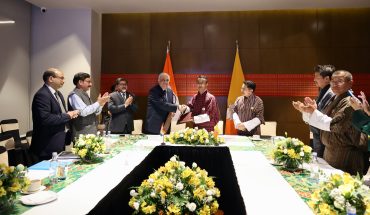
CHONEY ZANGMO
Thimphu
This orange export season has proven to be fruitful for Pelden Export and Import, a leading exporter in the south, with 74 consignments of oranges shipped to Bangladesh this winter. The company’s total investment was around Nu 25 million, marking apositive economic boost for the stakeholders involved.
The oranges were sourced locally from about 125 farmers within Bhutan. According to Kinley Namgyel, the head of Pelden Export and Import, this year’s orange trade has been significantly better than that of the previous year.
“The farmers seem happy with the pricewe offer, and the overall process has been smooth. There haven’t been any major challenges duringexport,” said Kinley.
Similarly, Rin Yang Export in Dewathang, Samdrup Jongkhar, has also seen success this season, with 71trucks of oranges exported so far. Their total investment stands at USD 0.3 million.
Like Pelden, Rin Yanghas faced no challenges during the export process and believes that the farmers are satisfied with the price being offered.
The company has also contributed to local employment, hiring 8 to 9 students to assist with the operations. These students were paid on a per-box basis providing them with the opportunity to earn during their winter break.
Farmers like Pema Dorji, 46, from Norbugang, have reaped varying levels of success from the orange season. Pema sold around 20 single cabins of oranges to Nganglam orange depot and 4 single cabins to Gelephu. While he earned Nu 40,000 to 50,000 per trip to Nganglam, he found the price relatively low. However, his sales in Gelephu were more profitable, earning him between70,000 to 80,000 per trip.
“Overall, this year has been better for orange farming compared to last year. I am content with the prices from Gelephu, though there’s room for improvement in Nganglam,” said Pema, expressing optimism for thefuture seasons.
Exporters are offering Nu 1,400 per box for large mandarins (meel) and Nu 1,200 per box for small mandarins (keel) this season. In Bangladesh, the prices increase to USD 15 and USD 12 per box, though the final rates fluctuate based on exchange rates set Bangladeshi importers.
In a significant shift, Gelephu Thromde has relocated the orange export depot to state-owned land in Namkhailing, near the Bhutan-India border, moving away from the previous practice of leasing private land.
Exporters contributed Nu 50,000 each the depot, with the expenses to be reimbursed by orange suppliers at the end of the season.
The funds were used to enhance infrastructure, including the installation of water supply, electricity, and improved road access. Trenches were built to keep wildlife out, and water tanks were set up to control dust ensuring better facilities for exporters and suppliers.
According to Bhutan Trade Statistics 2023, Bhutan exported mandarins worth Nu 50.86 million, amounting to 13,382,788 kilograms. Mandarin production saw a dramatic increase in 2023, reaching 21,170 metric tonnes (MT) compared to just 2,703 MT in 2022. Grown primarily for export to Bangladesh and India, mandarins are cultivated in all dzongkhags, except Bumthang, with 26,963 growers nationwide.
Dagana remains the largest producer, harvesting 4,690.77 MT from 2,907 growers, followed by Samdrup Jongkhar which produced 2,653.67 MT from 1,916 growers.
With the smooth logistics and higher earnings for farmers and exporters, the orange season is a welcome boon for Bhutan’s agricultural sector. Farmers and exporters alike are hopeful that this momentum will continue, further strengthening Bhutan’s position inthe regional orange market.
As the season progresses, the contributions of local farmers, students, and exporters reflect a collaborative effort that sustains this vital industry in the south.





